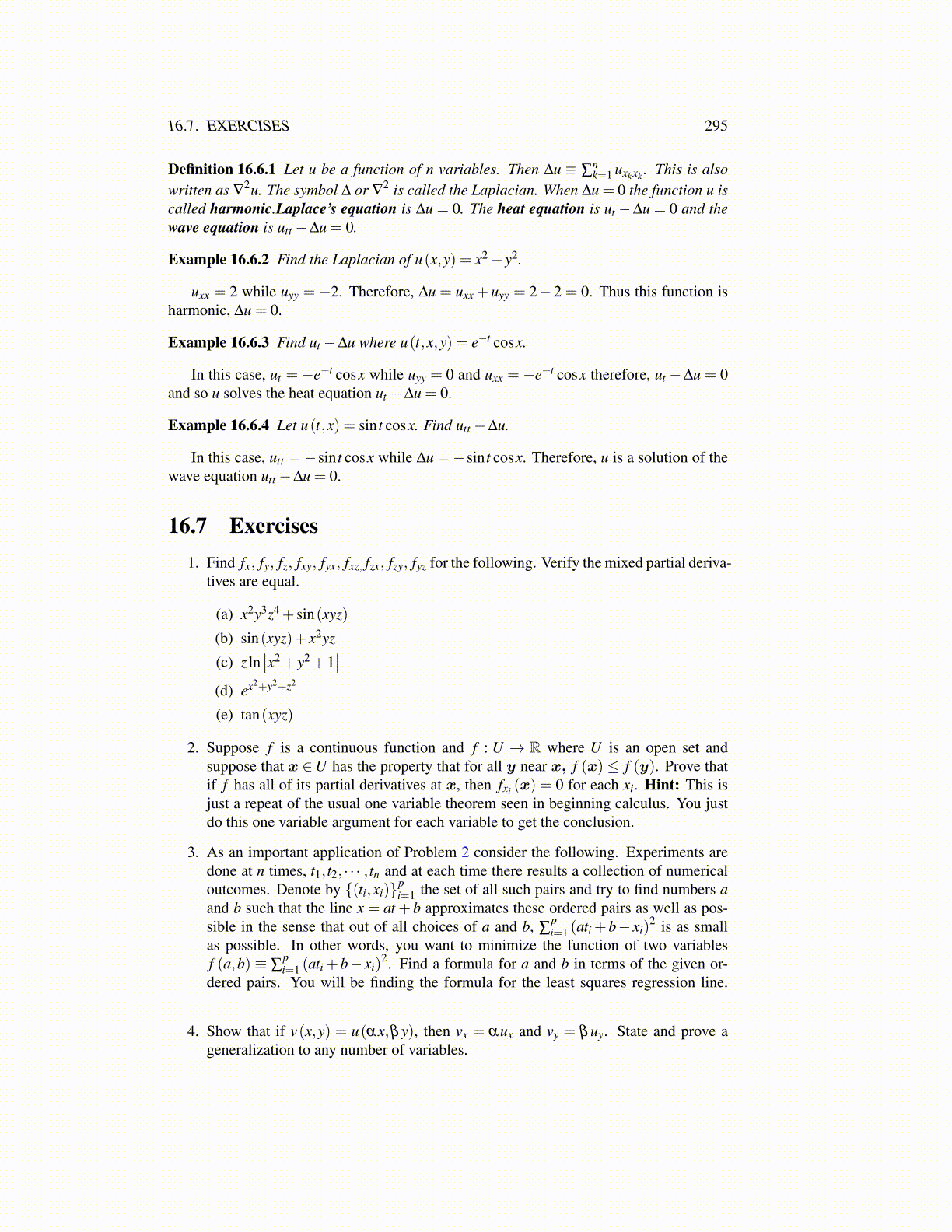
16.7. EXERCISES 295
Definition 16.6.1 Let u be a function of n variables. Then ∆u ≡ ∑nk=1 uxkxk . This is also
written as ∇2u. The symbol ∆ or ∇
2 is called the Laplacian. When ∆u = 0 the function u iscalled harmonic.Laplace’s equation is ∆u = 0. The heat equation is ut −∆u = 0 and thewave equation is utt −∆u = 0.
Example 16.6.2 Find the Laplacian of u(x,y) = x2− y2.
uxx = 2 while uyy = −2. Therefore, ∆u = uxx + uyy = 2− 2 = 0. Thus this function isharmonic, ∆u = 0.
Example 16.6.3 Find ut −∆u where u(t,x,y) = e−t cosx.
In this case, ut = −e−t cosx while uyy = 0 and uxx = −e−t cosx therefore, ut −∆u = 0and so u solves the heat equation ut −∆u = 0.
Example 16.6.4 Let u(t,x) = sin t cosx. Find utt −∆u.
In this case, utt =−sin t cosx while ∆u =−sin t cosx. Therefore, u is a solution of thewave equation utt −∆u = 0.
16.7 Exercises1. Find fx, fy, fz, fxy, fyx, fxz, fzx, fzy, fyz for the following. Verify the mixed partial deriva-
tives are equal.
(a) x2y3z4 + sin(xyz)
(b) sin(xyz)+ x2yz
(c) z ln∣∣x2 + y2 +1
∣∣(d) ex2+y2+z2
(e) tan(xyz)
2. Suppose f is a continuous function and f : U → R where U is an open set andsuppose that x ∈U has the property that for all y near x, f (x) ≤ f (y). Prove thatif f has all of its partial derivatives at x, then fxi (x) = 0 for each xi. Hint: This isjust a repeat of the usual one variable theorem seen in beginning calculus. You justdo this one variable argument for each variable to get the conclusion.
3. As an important application of Problem 2 consider the following. Experiments aredone at n times, t1, t2, · · · , tn and at each time there results a collection of numericaloutcomes. Denote by {(ti,xi)}p
i=1 the set of all such pairs and try to find numbers aand b such that the line x = at + b approximates these ordered pairs as well as pos-sible in the sense that out of all choices of a and b, ∑
pi=1 (ati +b− xi)
2 is as smallas possible. In other words, you want to minimize the function of two variablesf (a,b) ≡ ∑
pi=1 (ati +b− xi)
2. Find a formula for a and b in terms of the given or-dered pairs. You will be finding the formula for the least squares regression line.
4. Show that if v(x,y) = u(αx,βy), then vx = αux and vy = βuy. State and prove ageneralization to any number of variables.